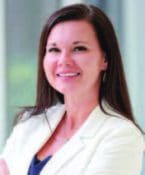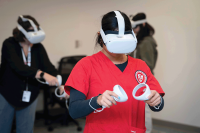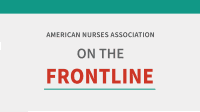Younger nurses seek belonging, leadership opportunities, solutions for workplace challenges






As healthcare continues to evolve, the nursing profession must engage the emerging workforce, particularly Millennial and Generation Z (Gen Z) nurses. These generations bring unique perspectives, values, and behaviors that are reshaping nursing. Millennials, born between 1981 and 1996, and Gen Z, born between 1997 and 2009, prioritize work-life balance, professional development, and technological integration in their careers. They’re deeply concerned with issues such as mental health and wellbeing; workplace diversity, inclusion, and belonging; and sustainable practices that support a work-life balance.
In 2022, the American Nurses Association (ANA) Board of Directors (BOD) created an advisory group to better understand the hesitancy of younger generations to become ANA members. The initiative was created to represent both Millennial and Gen Z generations (MZ nurses). The advisory group consisted of representatives from ANA Constituent and State Nurses Associations (C/SNAs) and ANA staff; 85% were of the MZ generations. To place ANA in an optimal position to engage the youngest generations of nurses, the group examined the entire ANA Enterprise.
Sarah Sladek, founder and CEO of XYZ University, a generational research and strategy development firm, partnered with the advisory group. Sladek is an author and subject matter expert on membership and workforce engagement shifts. Understanding and addressing the personal values and concerns of MZ nurses is crucial for fostering a supportive and innovative healthcare environment that effectively meets the demands of the future.
New nurses and clinical judgment
Generational learning preferences
The ANA BOD recognized that the value proposition of membership, along with ANA Enterprise products, services, and communication channels, had been designed primarily with Generation X and Baby Boomers in mind. To ensure these programs and services remain relevant, they required reassessment from the perspective of younger generations. This led the advisory group, in collaboration with XYZ University, to conduct an extensive multiphase research project to identify engagement gaps between MZ-aged nurses, the nursing profession, and ANA. The project focuses on how to better align with the needs of younger nurses and create growth opportunities for ANA. Ultimately, this initiative aims to enhance ANA’s relevance, sustainability, and overall success for future generations. (See ANA Advisory Group Multiphase Research Design Components)
ANA Advisory Group Multiphase Research Design Components
- Inter-Generational Baseline Surveys (February 2023): To gain a 360-degree perspective of the organization, XYZ University surveyed current and former ANA members and nurses who’ve engaged with ANA but never joined. The member survey garnered 7,002 responses. The nonmember survey received 10,036 responses.
- Generational Diagnostic (May 2023): Survey data consisted of both qualitative and quantitative data. XYZ University reported on macro trends (majority response) and micro trends, creating a dashboard of responses by generation to identify gaps and trend lines.
- Trends Analysis (May 2023): XYZ University researched major industry trends such as changing work environments, burnout, turnover, robotics and new technology, and evolving branches of the profession (such as travel and concierge nurses). XYZ University also cited membership engagement trends and shifting market expectations of organizations like ANA.
- Workplace Assessment (June-July 2023): In a survey on nursing as a career, 233 nurses younger than age 41 responded. This identified what younger nurses feel and experience in their day-to-day jobs. Nurses weighed in on work environments, interactions with leaders, and whether their workplaces were supportive and prioritized belonging, inclusion, and engagement.
- Nurse Interviews (July-August 2023): XYZ University conducted qualitative in-depth interviews (IDIs) with 41 MZ nurses younger than age 41. These IDIs generated valuable insights into the challenges and opportunities nurses encounter in their careers and experiences with ANA.
- Stakeholder Retreat (September 2023): In a virtual retreat, 21 stakeholders gathered. They represented the entire ANA and C/SNA community in terms of ages, background, roles, races, genders, and career stages. These innovative, optimistic, and forward-thinking individuals also reflected a mix of ANA employees, members, and volunteers; about half were MZ generations.
- Leadership Presentations (October 2023-March 2024): Members of the MZ Advisory Group and consultant Sarah Sladek presented research findings and insights on generational markers, shifting market drivers, and new membership engagement strategies to the Advisory Group, C/SNA leaders, and ANA Board of Directors.
- Hypothesis Confirmation Survey (February-March 2024): ANA executed a quantitative survey designed to validate the many hypotheses of MZ nurses developed during the quantitative and qualitative research phases of the project. In total, 1,263 MZ nurses (1,095 Millennials, 168 Gen Zs) responded. The survey also received responses from 2,300 nurses older than the MZ target range.
Research findings
Based on the multiphase research design, the advisory group identified two themes of importance to MZ nurses: unhealthy and hostile work environments and lack of belonging in ANA.
Millennial and Gen Z nurses face significant workplace challenges. Unhealthy and hostile work environments rose to the top as an ongoing and even escalating concern with wide consensus among survey respondents. Pressures during the COVID-19 pandemic intensified baseline challenges, such as insufficient training, support, and empathy. For example, ANA members and non-members cited hostility from tenured nurses towards MZ nurses. ANA’s response to this issue left MZ nurses questioning its stance and organizational values. In addition, the nurse staffing shortage remains a significant challenge, perpetuating issues like lack of support, burnout, stress, financial concerns, and age-related stereotypes experienced by MZ nurses.
Millennial and Gen Z nurses report not experiencing belonging within ANA. Generational gaps in technology use, economic changes, and human capital contribute to this disconnect. The Millennial generation is the predominate demographic among nurses, and they expect ANA to reflect their values and to take seriously their ideas, interests, and leadership. They seek skills and educational training, opportunities to use their voices by having a seat at the table, and a sense of being known and supported. MZ nurses want to pursue opportunities for learning, leading, and making a difference without being hindered by excessive bureaucracy. This would enable them to engage more easily and foster the sense of belonging they crave.
Survey respondents reported that ANA has been slow to meet the demands of younger generations. However, 70% of MZ participants agreed with the statement, “I feel it is important for nurses my age to join ANA.” This shows promise for creating a bridge that will enhance younger nurses’ participation and cultivate an environment where they belong.
Discussion
Culture drives engagement and retention significantly. However, in the view of MZ nurses, ANA’s culture mirrors healthcare settings where MZ nurses struggle to find a sense of community. MZ nurses want to be at the center, creating and delivering solutions and leading new opportunities to grow. However, the history of nursing is embedded with expectations of paying one’s dues by building credibility and obtaining years of experience before being recognized as an expert. ANA needs to embrace a necessary culture shift to engage younger nurses.
Inadequately responding to these workplace perspectives, demographic changes, economic difficulties, and technological advances not only will cause MZ nurses to become more disengaged and even leave the profession but also risk ANA becoming irrelevant. Disengaged MZ nurses will seek professional engagement within organizations that reflect their values and experiences. They’re demanding a sharp focus on fostering positive and inclusive work environments that promote work-life balance and innovation.
Recommendations
Based on outcomes from this multiphased research effort, the advisory group made several recommendations for ANA to meet the needs of MZ nurses. These include the following:
Remove barriers to belonging. A hierarchical approach to leadership has cultivated a culture replete with stereotypes, generational gaps, lack of innovation, aging membership trends, struggles with modernization, suboptimal succession planning, and burnout. These factors directly contribute to MZ nurses’ disengagement with ANA. Establishing a team to address these barriers will create a space for inclusivity and innovation. The advisory group recommended revising ANA shared governance bylaws to require at least 25% of participants be younger than age 40. This shift will help bring ANA into the future and foster belonging among the crucial MZ generations.
Strategic planning and training. The advisory group called for organizational-wide training among ANA leaders and customer-facing staff to better understand the differences and driving motivations of MZ nurses. When both leaders and other employees understand what influences MZ nurses to join, buy from, volunteer, and engage with ANA, planning will have a different outlook. Participation by group members and/or delegates must be woven into all facets of both ANA and its C/SNAs. Additionally, a to-be-developed strategy playbook will serve as a training tool and resource guide for the ANA community to inform, shift thinking, and integrate strategies of inclusivity and engagement.
Leadership opportunities. ANA should enable MZ nurses to innovate and engage in strategic planning, thereby enhancing their leadership skills and providing valuable insights from their perspective. Lack of this type of participation has led them to distrust ANA. Engaging MZ nurses in leadership will mitigate this lack of trust.
Communication. Investing in resources and a multipronged strategy to bridge communication gaps should be a top priority. Otherwise, MZ nurses will continue viewing ANA technologies as obsolete and irrelevant. Text messaging and social media should be part of the mix, in addition to current communication modalities such as email and the members-only online community. MZ nurses want easily accessible, personalized communication networks that mimic their preferred communication methods. Key stakeholders, advisory group members, and MZ nurses should be leveraged to comprehensively review current communication channels and outreach methods with an eye for incorporating innovative strategies that ensure optimal outreach and information sharing. Investing to leverage cutting-edge technologies like AI and predictive modeling also is essential to improving communication with MZ nurses.
The advisory group or delegates partnering with ANA to implement a marketing and outreach strategy will foster innovation and creative problem-solving. ANA and C/SNA members want their nursing community to be thought leaders and influencers, making this new paradigm vital in building trust with ANA.
Belonging. Young nurses feel burned out, overlooked, and neglected, all of which are contagious attitudes. Consequently, MZ nurses who join ANA must feel appreciated and valued; an emotional connection to ANA is fundamental to their primary and ongoing engagement. ANA will benefit from the perspectives and experiences of MZ nurses by asking key questions, such as what happens when they decide to get involved with ANA and what leads them to a sustained connection. Alongside routinely collecting this qualitative data, the advisory group recommended designating a key member of the ANA team whose sole responsibility would be to recognize and support the MZ generation. This, we believe, will foster a sense of belonging and a culture of sustained recognition.
Take the Lead in Solving MZ nurses’ biggest problems. Data collected in this research identified significant workforce challenges such as staffing shortages, mental health concerns, work-life balance, financial health, and toxic work environments, all of which contribute to significant turnover within the nursing workforce. Nurses of all ages, particularly the MZ generation, want ANA to lead in solving these problems (See Recommendations to solve MZ nurses’ biggest problems.).
Recommendations to solve MZ nurses’ biggest problems
- Release results of this study to national media, political leaders, and healthcare employers
- Utilize mentoring programs and the ANCC Practice Transition Accreditation Program
- Partner with academia to ensure nurses entering the workforce are practice-capable and aware of these issues prior to their licensure
- Implement training programs that help younger nurses enter leadership positions
at ANA and within the nursing profession - Encourage younger nurses to participate in organizational leadership and committees by adjusting ANA bylaws to require a membership presence of nurses younger than age 40
- Enhance career development tools and resources
- Adopt awards programs to recognize
outstanding young nurses
The work ahead
Based on the results of this initial Phase 1 research, ANA has moved into a projected 18-month Phase 2 effort to further explore recommendations and develop clear action plans. Expanding communication and technology capabilities, integrating inclusivity and belonging, and promoting innovation and leadership training will serve as guiding principles for the advisory group’s work.
—The authors serve on the advisory group. Benita N. Chatmon is president of the Louisiana State Nurses Association and assistant dean for clinical nursing education at the LSU Health Science Center School of Nursing in New Orleans. Stephanie McClellan is president of the Delaware Nurses Association and cancer institute manager at Bayhealth Medical Center in Dover, Delaware. Andrea Laliberte is a director of the ANA Massachusetts Board of Directors and Pathway to Excellence Program Manager at Southcoast Health in Fall River, Massachusetts.




















